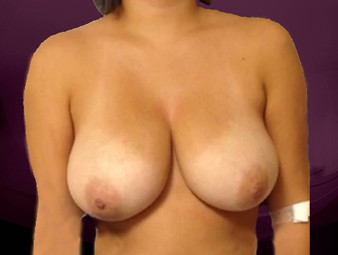
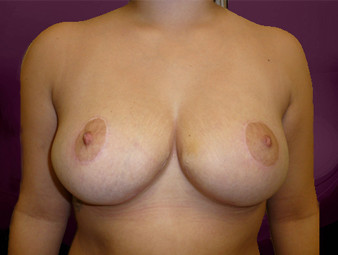

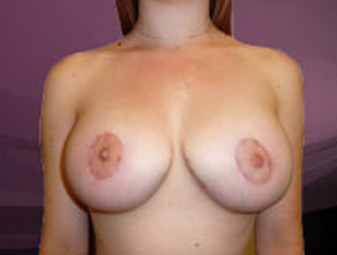


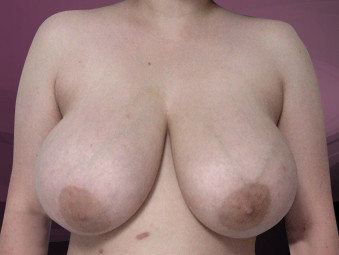
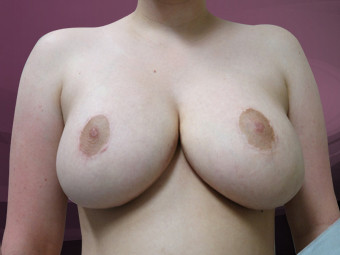
Large breasts can be a burden—and not a small one. An estimated 1 million women in the U.S. are affected by extremely large breasts, suffering from physical symptoms like backaches, neck pain, persistent headaches, shortness of breath and even numbness in their fingers or hands. For some, it’s almost impossible to find a bra that comfortably supports them.
While taking pain medication and investing in an ergonomic chair might help, these are temporary fixes. If you’re ready for a more significant change, breast reduction may be right for you.
What Is a Breast Reduction?
Breast reduction, or reduction mammoplasty, is a cosmetic surgery procedure that reduces your breast size to be in proportion with your body. During surgery, one of our board-certified and fellowship-trained cosmetic surgeons removes excess breast fat, glandular tissue, and skin to lessen the overall weight of your breasts.
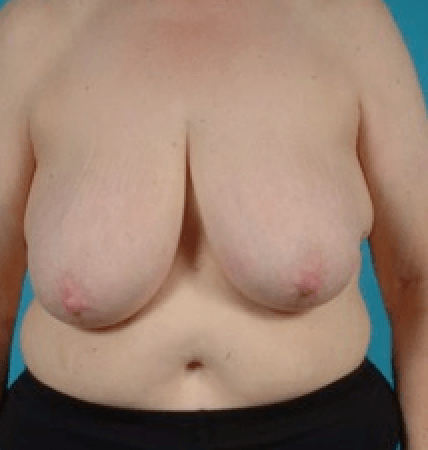

5’2″, 162 lbs. 6 months post op. Breast reduction inverted T technique.
Patient had persistent back and neck pain. wanted more youthful appearing breasts.
Are You Eligible for Breast Reduction?
According to the American Society of Plastic Surgeons (ASPS), you’re a good candidate for breast reduction surgery if:
- You feel that your breasts are too large.
- Your breasts limit physical activity.
- You experience back, shoulder, and neck pain caused by the weight of your breasts.
- Bra straps cause shoulder indentations.
- Your skin is irritated under your breast crease.
- You are physically healthy.
- You have realistic expectations for the procedure’s results.
- You don’t smoke.
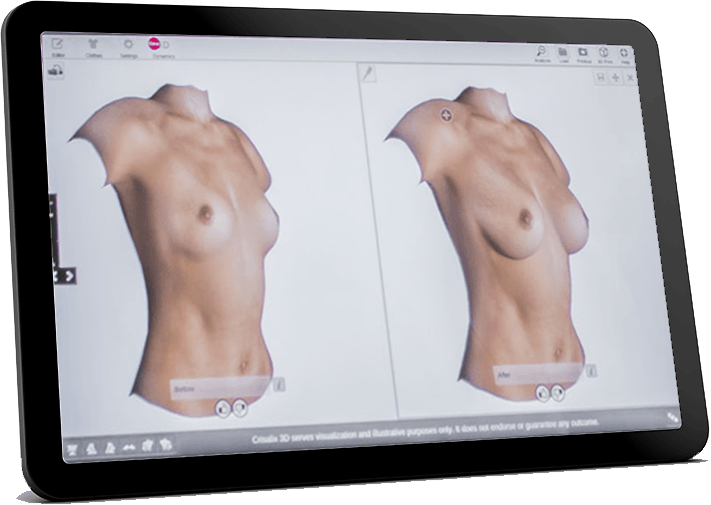
Free Crisalix imaging with Consultation
See the results of your surgery before you have the surgery
Contact us today to get started
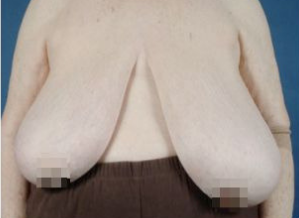
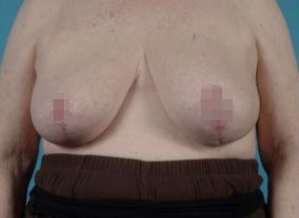
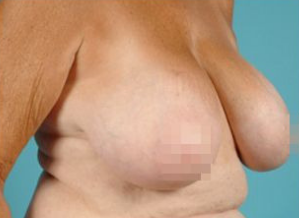
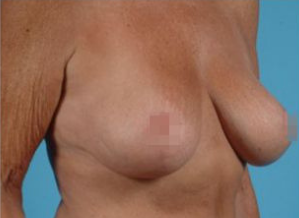
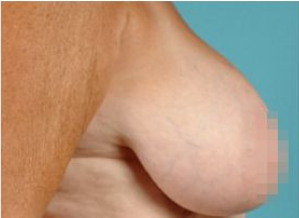
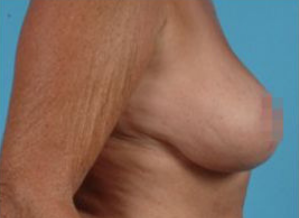
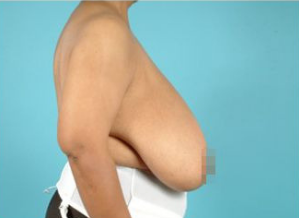
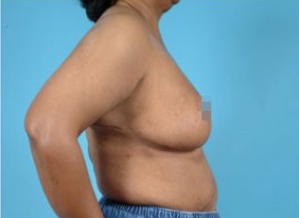
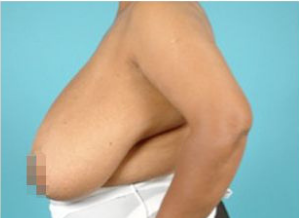

Breast Reduction Techniques
There are several breast reduction techniques. Traditionally, plastic surgeons use one of two methods:
- Vertical (“lollipop”)
- Inverted-T (“anchor”)
Your doctor produces a youthful, full breast reduction without the vertical scar seen in the majority of breast-reduction techniques: - No-Vertical-Scar
Vertical Breast Reduction
During a vertical breast reduction, your doctor makes two vertical incisions. Then he removes excess fat, excess skin, and excess breast tissue, reshaping the new smaller breast internally. Then he’ll lift your breast into a more youthful position on your chest.
Inverted-T Breast Reduction
The inverted-T method involves three incisions. This allows for more tissue to be removed and for more reshaping. The inverted-T method is best for you if:
- You need a more significant size reduction, and/or
- You have considerable asymmetry or sagging that your doctor can correct
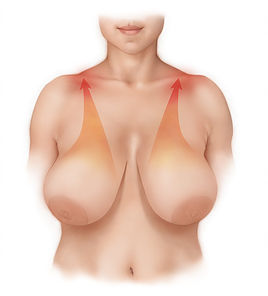
No-Vertical-Scar Breast Reduction
Some patients may be a candidate for a no vertical scar breast reduction. This technique was initially developed in the 1970’s, when surgeons began using breast dermal tissue to re-shape the breast. In properly selected patients, this technique can be used to reduce the need for a breast vertical scar. It involves removing excess fat and tissue, and re-positioning the breast mounds higher on the chest wall. The breast tissue is shaped into a “cone” to help maintain breast fullness and shape.
4 Phases of a No-Vertical-Scar Breast Reduction:
Phase 1: Your doctor removes excess fat and tissue and lifts your new breast mounds high on the chest wall.
Phase 2: Your doctor shapes the breast tissue into a “cone,” which ensures maximal breast fullness and cleavage and helps the breast shape last for as long as possible.
Phase 3: The new breast mounds are secured to the chest muscle, transferring weight away from the skin envelope.
Phase 4: Your doctor places the final sutures around your areolas and underneath your breast crease.
Does Breast Reduction Cause Scars?
The vertical and inverted-T methods both result in vertical scarring. While no breast reduction surgery is completely free from scarring, there is a technique that minimizes scarring and strategically hides your incisions. At DFW Center for Aesthetics and Cosmetic Surgery, we use the no-vertical-scar method, which does a nearly perfect job of eliminating vertical scarring and provides a perky shape that isn’t achieved by traditional techniques. Your incision sites are hidden at your areolas and in the shadows of your breast creases for a more seamless look and feel.
Breast Reduction: The Consultation
When you meet with one of our board-certified and fellowship-trained cosmetic surgeons, you’ll be greeted with his warm smile and extensive knowledge. He will ask you several questions during your breast reduction consultation, like your reasons for wanting a reduction and how small you’d like to go. Also be prepared to talk about:
- Your expectations for the surgery
- Medical history, including a family history of breast cancer and results of any previous mammograms or biopsies
- Any existing medical conditions
- Allergies
- Current use of prescription drugs, dietary supplements, alcohol, tobacco and/or recreational drugs
- The use of anesthesia during surgery, as well as any potential risks of the procedure
Your doctor will perform a breast exam to assess your:
- Breast size
- Shape
- Skin quality
- Placement of your nipples and areolas
He’ll also take pictures for your medical records only.After a thorough evaluation, plenty of time for your questions, and a thoughtful discussion, your docto will offer his professional recommendation for your unique needs.
Breast Reduction: The Procedure
Breast reduction surgery with one of our board-certified and fellowship-trained cosmetic surgeons is an outpatient procedures that takes place at our surgery center in Southlake, TX. All breast reduction surgery begins with the administration of anesthesia. Based on what’s best for you, your doctor will recommend either intravenous sedation or general anesthesia. The procedure itself lasts between one and two hours.
Breast Reduction: Post-Surgery Care & Recovery
Post-surgery, your incisions will be dressed with bandages. You can wear an elastic bandage or a sports bra to minimize swelling and support your breasts. A small tube may be placed under your skin to drain excess blood and fluid. Your escort can transport you home after you wake up from anesthesia. Ahead of surgery, be sure to ask your doctor any questions you have about the post-surgery experience, like:
- Where you’ll be taken once surgery is complete
- What medications may be prescribed
- How to replace your bandages and clean the area
The total recovery time for breast reduction surgery varies, but expect about three months of healing. It’s best to avoid heavy lifting for at least six weeks after surgery. We’ll have you schedule a follow-up visit, so your doctor can assess your healing progress and answer any further questions you have.
Breast Reduction Risks
Every cosmetic procedure comes with risks. Your doctor will be happy to talk to you about any concerns you have or questions you’d like answered. The American Society of Plastic Surgeons indicates that breast reduction complications can be:
- Unfavorable scarring
- Infection
- Anesthesia risks
- Changes in breast or nipple sensation
- Blood clots
- Poor wound healing
- Bleeding (hematoma)
- Breast asymmetry
- Fluid accumulation
- Excessive firmness of the breast
- Pain (which may persist)
- Possibility of revisional surgery
How to Pay for Breast Reduction Surgery
Our office accepts several payment options, including healthcare credit cards issued by Comenity® Capital Bank (Alphaeon Credit®) and Synchrony Bank (CareCredit®). You may also choose a secured loan from United Medical Credit or Enhance Patient Finance. United Medical Credit is suitable for prime and subprime lenders and has multiple plan options and flexible terms.Or you can pay by:
- Cash
- Credit card
- Cashier’s check
- In-house financing
- Other types of loans
When you’re ready to regain your confidence and free yourself from chronic discomfort, the professional team at DFW Center for Aesthetics and Cosmetic Surgery is ready to support you. Book your consultation today to discuss your breast reduction options. Our team serves all Dallas / Ft Worth area.




